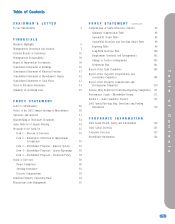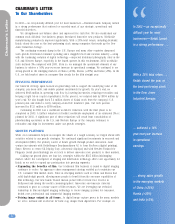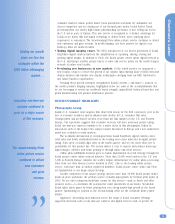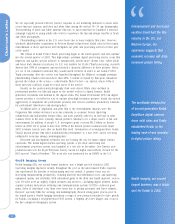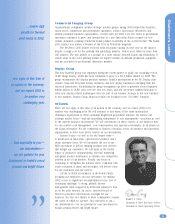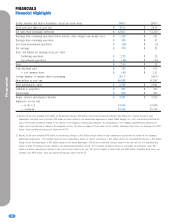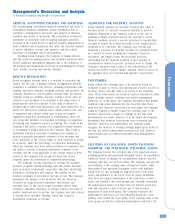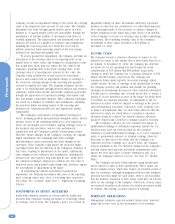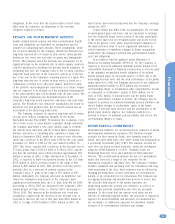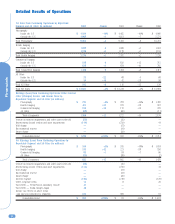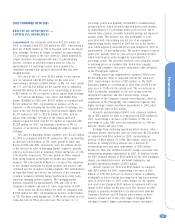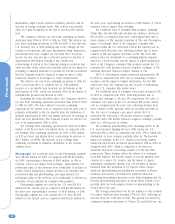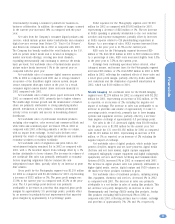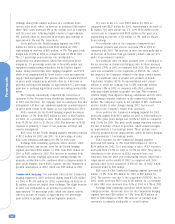Kodak 2002 Annual Report Download - page 4
Download and view the complete annual report
Please find page 4 of the 2002 Kodak annual report below. You can navigate through the pages in the report by either clicking on the pages listed below, or by using the keyword search tool below to find specific information within the annual report.
Chairman’s Letter
4
We are especially pleased with the positive response to our marketing initiatives to boost sales
of one-time-use cameras and black and white films among the critical 18 – 34 age demographic.
Test marketing of black and white amateur film was so successful that we launched a national
campaign targeted to young adults who want to experience the fun and unique benefits of black
and white photography.
Photofinishing volumes in the U.S. were lower due to lower industry film sales. However,
wholesale photofinisher acquisitions in Western Europe helped boost Kodak sales in that region.
Consolidation of these operations will strengthen our print and processing services in that part
of the world.
The rollout of Kodak Perfect Touch processing began in the fourth quarter and will continue
into the second quarter of 2003. This high-volume, premium digital processing service scans film
negatives and applies special software to automatically provide more vibrant color, richer detail
and fewer dark shadows in pictures. In U.S. test markets for Perfect Touch processing, research
showed that 74% of consumers surveyed noticed a dramatic difference in their pictures. Better
yet, six of ten consumers indicated they would switch retailers in order to use Kodak Perfect
Touch processing. After the service was launched throughout the Midwest, overnight premium
photofinishing volumes increased more than 20%. A similar reception by European consumers
greeted the rollout of the service — called Kodak Photo Perfect — in Austria, where 64% of
those surveyed said they would be repeat users of the service.
Results on the professional photography front were mixed. While sales declined in
professional markets for film and paper as the market evolves to digital formats, Kodak
generated excitement and demand in the digital arena. The Kodak Professional DCS 14n digital
camera provides a cost-effective way to capture ultra-high resolution pictures. Kodak also moved
aggressively to implement the professional products and services workflow productivity solutions
for professional laboratories and photographers.
Worldwide sales of origination and print film to the entertainment industry were flat.
Origination film volume decreases were due primarily to economic factors impacting
commercials and independent feature films, and were partially offset by an increase in print
volumes. Even in the slow economy, motion pictures continue to be a major source of fun and
entertainment for millions of people. U.S. moviegoers spent a record $9.3 billion on theater
tickets in 2002. We’re proud to note that 100% of the motion pictures nominated for major
2002 Academy Awards were shot on Kodak film stock. Introduction of second-generation, Kodak
Vision2 motion picture film takes traditional film performance to a new level, and is receiving
enthusiastic reception among cinematographers.
Research and development scientists also are leading the way for future digital cinema
operations. The Kodak digital cinema operating system, a pre-show advertising and
entertainment projection system, was launched at a test site in December. Our Cinesite post-
production unit won the Royal Television Society Award for digital visual effects created for the
HBO special, “Band of Brothers.” The work also was nominated for an EMMY in the U.S.
Health Imaging Group
Health Imaging (HI), our second largest business, was a bright spot for Kodak in 2002.
Operating margins improved steadily throughout the year as the unit reduced SG&A expenses
and experienced the benefits of restructuring and cost control. A primary focus was on
increasing manufacturing productivity, reducing material and distribution costs, and improving
equipment quality and reliability. With substantial gains in the third and fourth quarters, year-to-
year HI sales were up slightly. Digital products and services — including digital printers, media,
capture systems and picture archiving and communications systems (PACS) — achieved good
gains. Sales of traditional x-ray films were lower due to pricing pressures and lower volumes.
However, specialty films for oncology and mammography showed strong gains year-to-year. In
the fourth quarter, Health Imaging introduced a range of new products intended to drive growth
for Kodak —including a next-generation PACS system, a flagship dry laser imager, and a top-of-
the line computed radiography system.
Health Imaging, our second
largest business, was a bright
spot for Kodak in 2002.
The worldwide introduction
of second-generation Kodak
EasyShare digital cameras
drove solid sales and firmly
established Kodak as the
leading ease-of-use innovator
in digital picture taking.
Unemployment and decreased
vacation travel hurt the film
industry in the U.S. and
Western Europe. Our
experience suggests that
economic recovery will drive
increased picture taking.
“

